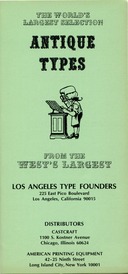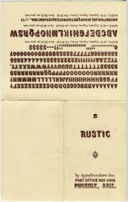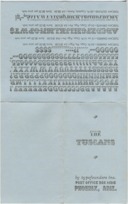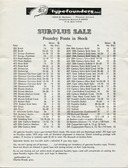Phoenix, Arizona. ? - 1967. Charles Broad. Lasko dates Charles Broad's death and the closing of this foundry to 1967. Matrices and machinery acquired by Los Angeles Type Founders. Stock of cast type (fonts and sorts) acquired by John Horn. Some standard Lanston Monotype (display?) matrices disposed of earlier to Morneau Typographers. The disposition of his wood type (used for reproduction proofs) is unknown.
Typefounders, Inc. of Phoenix was noted for having either acquired or had manufactured for it matrices for many "antique" (meaning 19th century) and ornamental typefaces. These matrices passed to Los Angeles Type Founders and then to Barco. In 2010 these mats were acquired by Skyline Type Foundry.
Fritz Klinke has kindly provided some information on Broad and his work in Chicago and Phoenix.
Apparently, Broad operated a matrix rental service in Chicago. in the 1950s. He would seem to have dealt in secondhand equipment, because surviving documentation from Lanston Monotype (in Klinke's possession) indicates that Lanston specifically disavowed ever having sold him machinery or matrices or having had any business dealings with him.
He attempted, unsuccessfully, to sell a redesigned matrix box to Lanston.
When he moved to Phoenix, he became associated with Morneau Typographers. He cast type on their Lanston Monotype sorts caster. He also acquired a Koike caster (a Japanese Thompson derivative), since lost (though the matrix carrier and foundry matrix holder for this machine survive and are now in the possession of Skyline Type Foundry).
As shown in the specimens below, in Phoenix Broad sold both standard Lanston Monotype faces and the so-called "antique" faces for which he became noted; he phased himself out of the standard faces to concentrate on the "antiques" around 1959.
These "antique" faces were modern copies of various earlier faces (primarily 19th century), with a few contemporary faces as well (e.g., his " Dimension" was an unauthorized copy of Roger Excoffon's 1958 design Calypso from Fonderie Olive).
Broad is known to have acquired matrices for these faces from Harry Weidemann, John S. Carroll, and Andrew Dunker. To judge from the matrices surviving at Skyline Type Foundry, he would seem also to have commissioned matrices from other sources (probably Japan and possibly India).
Broad also acquired regular Lanston Monotype matrices (display matrices, I believe) from Archie Little Typographers. Some of these ended up with Morneau Typographers and from there to Fritz Klinke.
He was not himself a maker of matrices. I have yet to determine whether he was himself a casterman, though it seems likely that he was.
Lasko, David J. "Pinmarks, Nicks and Grooves: Some Notes on the History of American Typefounding," Festina Lente, Vol. 1, No. 1 (Feburary, 1980): 14.

Specimen 7A (December, 1962)
"Gay 90's Foundry Cast Antiques and Ornates." Number 7A (December, 1962). Thanks are due to Jenny Addison, proprietor of Lock and Key Press (http://lockandkeypress.wordpress.com for scanning this specimen and making it available.

Antique Types
This illustrates the types cast from matrices acquired by LATF from Typefounders, Inc. (of Phoenix). These were in turn in part the work of Weidemann and of Carroll / Replica Type Foundry. The matrices for these types (along with the rest of LATF) were (was) acquired by Barco. These matrices in particular were acquired in November 2010 by Skyline Type Foundry.
Thanks are due to Sky Shipley of Skyline Type Foundry for making this specimen available.
(The link here goes "up and over" to the actual reprint of this specimen in the LATF Notebook. Note that the "Antique" typefaces appeared in other LATF specimens, including at least one printed during the period when Typefounders, Inc. was in business. One presumes that LATF was in that instance reselling the type.)

Arboret, 24 pt. Caps, Figs, Points, Ornaments
Undated specimen for Weidemann's Arboret (q.v. in Typeface Index). This is a folded brochure, scanned here unfolded as a single image. Thanks are due to Jenny Addison, proprietor of Lock and Key Press ( http://lockandkeypress.wordpress.com ) for making this available.
N.B., the Weidemann Arboret is a copy of MacKellar, Smiths and Jordan's Arboret No. 2 (q.v. in Typeface Index), not their Arboret.
The Skyline Type Foundry. matrix inventory does not list Arboret.

Gold Rush, 24 pt. Caps, Figs, Points
Undated specimen for Gold Rush, Carroll Copy (q.v. in Typeface Index). This is a folded brochure, scanned here unfolded as a single image.
The Skyline Type Foundry. matrix inventory lists Gold Rush at 24 pt.

Rustic, 12, 24, 36 pt. Caps, Figs, Points
Undated specimen for Rustic, Carroll Copy (q.v. in Typeface Index). This is a folded brochure, scanned here unfolded as a single image.
The Skyline Type Foundry. matrix inventory lists Rustic at 12, 24, and 36 pt.

The Tuscans (Ombree, Ornate, Outline)
Undated specimen for Tuscan Ombree (Weidemann, q.v. in Typeface Index), Tuscan Ornate (probably Weidemann, q.v. in Typeface Index), and Tuscan Outline (Weidemann, q.v. in Typeface Index), This is a folded brochure, scanned here unfolded as a single image.
Tuscan Ombree is shown in a full font at 24pt, Caps, Figs, Points; it is identified but not shown at 15 on 14 pt, Caps, Figs, Points. Tuscan Ornate is shown (partial line) at 24 pt, Caps, Figs, Points. Tuscan Outline is shown (one-line specimen) at 30 pt, Caps, Points (no Figs).
The Skyline Type Foundry. matrix inventory lists Tuscan Ombree at 18 and 24 pt (no 30 pt or 15/14 pt). It lists Tuscan Ornate at 18 and 24 pt. It lists Tuscan Outline at 30 pt (no 18 or 24 pt).

1959 Surplus Sale Flyer
Announcing their new focus on antique faces and disposing of "ordinary" type at a discount.
Clicking on the image brings up a reduced scale (but readable) version that is 4.1 Megabytes in size. Click here for the full-size version (100 Megabytes). In both versions, the scan of the envelope has been reduced very slightly (to about 99%) to fit.
Thanks are due to Jenny Addison, Prop. Lock and Key Press for making this available.

Antikue Wood Type
Antikue Wood Type. (Phoenix: Typefounders, Inc., 1959-09-01.) This is not a specimen of types for sale, but rather of wood types available for reproduction proof service. A reproduction proof is a service provided by a typefoundry (or a well-stocked printer) where the foundry would set copy for a customer in type which the customer did not wish to (or could not) purchase and provide to the customer not the type but a high-quality printed proof of the type. The customer would then use this proof in any of several photographically-based printing methods.
This present specimen is a 12 page folded brochure. The fourth page as reproduced is not upside-down; it was imposed incorrectly in the original. Large wood type is traditionally difficult to ink and print properly; presumably the actual reproduction proofs supplied would have been of higher quality than this specimen.
 Tuscan Graille
(Weidemann)
Tuscan Graille
(Weidemann)
 Tuscan Ornate
(Weidemann?)
Tuscan Ornate
(Weidemann?)
 Tuscan Outline
(Weidemann)
Tuscan Outline
(Weidemann)
All of the items reproduced here or from which images are reproduced here were published in the US without copyright notice at a time when such notice was required to secure copyright. They therefore passed into the public domain upon initial publication. The digital reprints of them here remain in the public domain.
All portions of this document not noted otherwise are Copyright © 2011 by David M. MacMillan and Rollande Krandall.
Circuitous Root is a Registered Trademark of David M. MacMillan and Rollande Krandall.
This work is licensed under the Creative Commons "Attribution - ShareAlike" license. See http://creativecommons.org/licenses/by-sa/3.0/ for its terms.
Presented originally by Circuitous Root®
Select Resolution: 0 [other resolutions temporarily disabled due to lack of disk space]